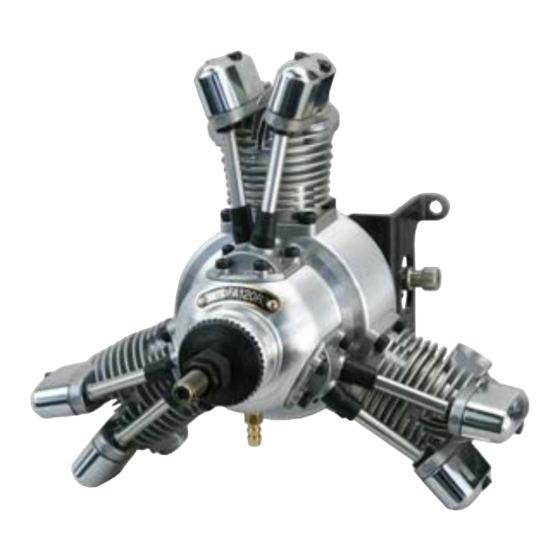Table of Contents
Advertisement
Quick Links
Instructions for SAITO FA-200R3 (AAC) 4-Stroke Engine
We would like to express our sincere thanks for your purchase of the SAITO FA-200R3
engine. Please read our instructions carefully and treat your engine with care. If there're
any manufacturing defects, SAITO Seisakusho co., ltd. will make necessary repairs free
of charge. You are requested to strictly avoid disassembling the engine since assembled
with the use of special tools and jigs to assure perfect construction.
In the case of breakage or trouble, if encountered due to crash or others, please send the
engine to our service station.
Please notice that our guarantee will not cover any breakage or trouble on the engine
caused by your disassembling or modification.
Principal outside dimensions
Bore
27.0mm×3
Stroke
19.2mm×3
Stroke volume
32.98cc
46cc/min (At full throttle, Fuel of synthetic oil with 15% of nitro content, at approx 9,000rpm)
Fuel flow
*Fuel flow varies depends upon prop load. More fuel flow with larger load and less fuel flow with smaller load.
Unique features of SAITO FA-200R3
Optimum for small-size scaled airplane
Low vibration (assured by constant-interval explosion)
Real sound of the exhaust.
The engine is designed to equalize fuel mixture and minimize misfire due to insufficient distributing at idling by means of special port type intake manifold
originally developed by SAITO.
Cylinder head: Improved semi-spherical combustion chamber assures better combustion efficiency and volumetric efficiency.
Cylinder: The aluminum cylinder is directly hard-chrome plated on its inner surface without installing liners to reduce weight and increase durability. The monolithic
structure of cylinder head and cylinder prevents distortion and improves cooling efficiency.
Piston: The piston is made of high silicon content aluminum and attached with a compression ring to heighten engine performance.・
Crankshaft: Has a forged solid construction made of chrome molybdenum steel, and supported by two ball bearings.
Cam: Features high cam providing longer maximum lift time.
Carburetor: High-performance of slow throttling type.
Propeller nut: designed to have double nuts preventing loosening and fall-off for the safety.
Standard Accessories
1. Wrench for tappet adjusting screw
2. Limit gauge (0.1t) for tappet adjusting
3. Hexagonal wrench (1.5mm)
4. Muffler complete
Weight
Approx. 1,385g (with mufflers)
Practical Speed
1,800-9,500rpm max range on the ground: 8,500-9,500rpm
Static thrust
Approx. 6-7kgf
1 pc.
1 pc.
1 pc.
1 set
Explosion order
(1-3-2)
The 4-Stroke engine provides 4 individual piston
movements as illustrated below. The "Stroke" means the
piston movement from the Top Dead Center to the Bottom
Prop rotational direction
Dead Center. In the 4-Stroke engine, one cycle of operation
in change of gas state inside the cylinder and valve
movement are completed at every 4 strokes of piston that is
every 2 revolutions of the crankshaft. Formally the engine is
1
called the 4-stroke one-cycle engine.
3
2
Cylinder numbers viewed
from the rear
5. Glow plug [SAI-GP01]
(Attached to the engine)
6. Plug heating connector set
(3pcs. of red cord, 1pc. of black, 2pcs. of fixture)
-1-
Mechanism of 4-Stroke Engines
Propeller
Standard APC16"×8"-10",17"×6"
3 pcs.
1 set
Advertisement
Table of Contents

Summary of Contents for Saito FA-200R3
- Page 1 Instructions for SAITO FA-200R3 (AAC) 4-Stroke Engine We would like to express our sincere thanks for your purchase of the SAITO FA-200R3 engine. Please read our instructions carefully and treat your engine with care. If there’re any manufacturing defects, SAITO Seisakusho co., ltd. will make necessary repairs free of charge.
- Page 3 Note: Strictly avoid changing the direction of carburetor installation. Failure to do this will cause engine malfunction. The SAITO carburetor has been adjusted on its slow needle to our reference value at factory default. The slow needle requires some correction depending on various factors including the installation position, types of prop/fuel/plug, or climate conditions.
- Page 4 On checking the gap, securely tighten (but not excessively) the lock nut. * In the case of the engines for vehicle, small gap is given to tappets to absorb valve elongation. In the case of SAITO engines, gap becomes larger during operations due to thermal expansion of the cylinder (made of aluminum).

















Need help?
Do you have a question about the FA-200R3 and is the answer not in the manual?
Questions and answers